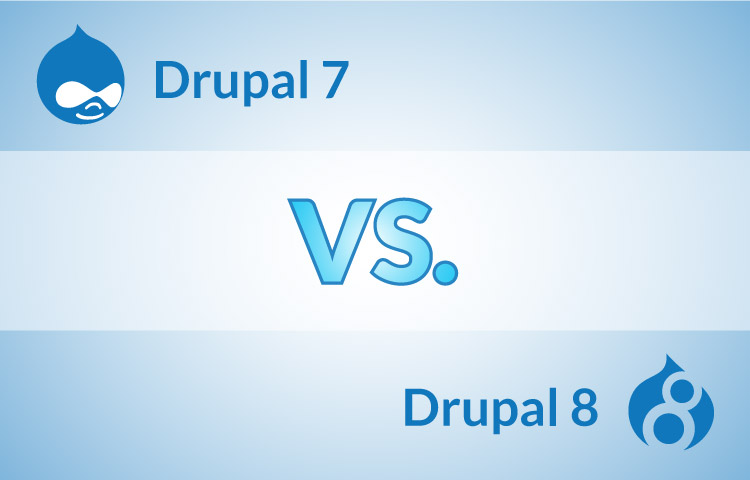Main Differences Between Drupal 7 and Drupal 8

Web development is moving really fast and Drupal is becoming day by day one of the top content management systems out there, in this article we will discuss the main differences between drupal 7 and drupal 8 and how it grew to become a framework. Drupal modules are considered as customizable elements that serve a particular purpose or feature in a website below are some of the main ones.
Drupal Modules
There is a different collection of "modules" available for Drupal, which have been developed by a community of developers and shared for public use. These can be installed onto a website to increase its functionality. Some contrib modules are in Drupal 8 core such as:
CKEditor
The CKEditor module builds on Drupal 8's Text Editor module to provide a deeply integrated CKEditor text editor out of the box. Unlike the contributed module in Drupal 7, the CKEditor module in Drupal 8 core
Core Multilingual
Drupal 8 accelerated multilingual website development by including four key modules in the core. While using Drupal 8, the developers can avail new modules like language, content translation, interface translation, configuration translation. The modules make it easier for users to configure language and apply to the content as well as translate the website.
Views & Views UI
Using the Views module, you can fetch content from the database of your site and present it to the user as lists, posts, galleries, tables, maps, graphs, menu items, blocks, reports, forum posts etc. Different content types including nodes, users, and other bundles can be displayed.
Breakpoint
Breakpoints are used to separate the height or width of viewports (screens, printers, and other media output types) into steps and provide for the case where a responsive design adjusts in order to display correctly on different devices. The Breakpoints module standardizes the use of breakpoints, and enables modules and themes to expose or use each others' breakpoints. The Breakpoint module keeps track of the height, width, and resolution breakpoints.
Configuration Manager
The Configuration Manager module is responsible for managing the collection of admin settings that determine how the site functions, as opposed to the content of the site. Configuration will typically include things such as the site name, the content types and fields, taxonomy vocabularies, and so on.
Media
The core Media module provides a 'base' entity for media assets. This allows you to standardize the way your Drupal site interacts with media resources. Local files or images, YouTube videos, Tweets, Instagram or Facebook posts, etc. can all be treated in a common way, regardless of where the media resource itself is ultimately stored. Being a standard Drupal content entity, you can reference and use this new entity in any place Drupal knows how to work with them.
Once installed, you will have the media entity type available. Just like with Nodes, with this new entity type you can create Media Types, add fields to them, manage display modes (for view and form operations), and so on.
EXPERIMENTAL:
Media Library extends the Media and File Entity modules to provide the ability to restrict which files are considered part of a site's media collection.
Drupal Core
Drupal 8 also added two field types into core listed below:
1- Datetime
The Datetime module provides a Date field that stores dates and times. It also provides the Form API elements datetime and datelist which other modules can make use of.
2- Telephone
The Telephone module allows you to create fields that contain telephone numbers.
It depends on the Field and the Field UI modules.
As with other fields a telephone field can be added to any bundle. This means you can add a telephone field to a user, a content type (news, event) or custom block.
Drupal 8 vs Drupal 7: New Theme Engine
Theme engines are how themes interact with Drupal. Drupal 8 comes with a new theme engine –Twig. Twig is a PHP-based theme engine which allows programmers to write templates using a simpler syntax. But the developers can still use Twig to crate templates which are both fast and secure. Hence, the developers can take advantage of the new theme engine provided by Drupal 8 to create beautiful and functional websites according to varying business needs.
Security
Drupal 8 also takes security seriously and calls for trusted host patterns to be specified in settings.php. You need to add the following:
$settings['trusted_host_patterns'] = array('^example\.com$',);
at the bottom of the file.
Drupal 8 vs Drupal 7 Cached Page Delivery
Drupal 8 is built on a PHP core that is slower to parse than Drupal 7 and uses more memory. On an empty Drupal installation you will really notice this difference because the empty shell will act like a magnifying glass on the underlying architecture. In the chart above you can see that Drupal 7 is more than twice as fast at delivering cached pages to anonymous users.
Conclusion
Drupal 8 is now getting more mature and developers are moving to Drupal 8 because of the flexibility it's offering. We at Complete Chain has implemented many complex successful projects using Drupal 8 that are active on the web and being maintained. Need help on your next project? Get a quote here and subscribe to our newsletter for fresh content about the world of web development.
If you’re a Drupal Developer and want to join our team of experts you can send your CV to this email [email protected]

